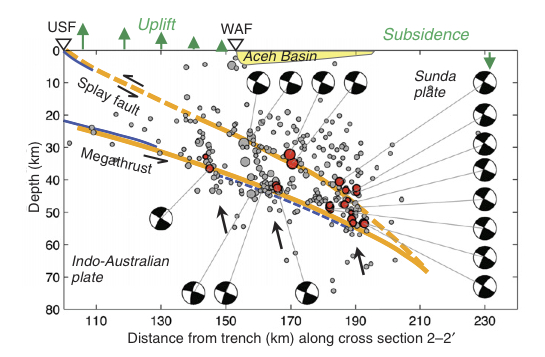Details resolved in the Sumatra-Andaman subdcution zone

| Global-scale high-resolution seismicity analysis |
|
This ongoing NSF funded project aims at improving the location precision of millions of earthquakes on a global scale by developing higher-order data processing and earthquake location methods (Waldhauser and Schaff 2007, 2008). These methods take advantage of the increasing quantity and quality of seismic archives available from IRIS, ISC, and NEIC and increase in computing power.
The new data will have the potential to reveal characteristic seismicity patterns in time and space, and provide new insights into earthquake processes.
This project will focus on using the wealth of new data to better understand, in a comparative way, the seismogenic structure and processes that control subduction zones worldwide. Results from this project are expected to find many applications in the Earth sciences, and to have social impact in the areas of natural hazards and seismic verification of the CTBT.
|
|
|
High-precision teleseismic cross-correlation based double-difference locations and focal
mechanisms of aftershocks of the 2004 Mw 9.2 Sumatra-Andaman
earthquake illuminate an active imbricate fault system in the
accretionary prism offshore northern Sumatra shown in the depth section to the right. They reveal repeated
failure of a shallow northeast-dipping thrust fault above the megathrust,
which we interpret to be the reactivation of a splay fault that
rises from the megathrust at ~55 km depth and cuts through the
overriding Sunda plate. The projected intersection of the splay fault
with the seafloor correlates with a recently active thrust fault (USF) seen in
postseismic bathymetry data west of the Aceh basin. A spatiotemporal
analysis of the streaky aftershock distribution indicates that ascending
fluids released from the subducting oceanic crust along inherited
seafloor fabric may control brittle fracture in the overriding plate. We
speculate that if the splay fault was active coseismically, it may have
led to amplified vertical uplift of the forearc ridge and contributed to
generating the cataclysmic near-field tsunami that struck the northwest
Sumatra coast following the 2004 rupture. For more details see Waldhauser et al. (2012).
|
|
 |
|
RELATED PUBLICATIONS Diehl, T., F. Waldhauser, J.R. Cochran, K.A. Kamesh Raju, L. Seeber, D.P. Schaff, E.R. Engdahl, Back-arc extension in the Andaman Sea: Tectonic and magmatic processes imaged by high-precision teleseismic double-difference earthquake relocation, J. Geophys. Res., 118, doi:10.1002/jgrb.50192, 2013. [PDF] Waldhauser, F., D.P. Schaff, T. Diehl, and E.R. Engdahl, Splay faults imaged by fluid-driven aftershocks of the 2004 Mw 9.2 Sumatra-Andaman earthquake, Geology, v. 40/3, p. 243-246, doi:10.1130/G32420.1, 2012. [PDF] Waldhauser, F. and D.P. Schaff, Regional and teleseismic double-difference earthquake relocation using waveform cross correlation and global bulletin data, J. Geophys. Res., 112, B12301, doi:10.1029/2007JB004938, 2007. [PDF] Waldhauser, F. and D.P. Schaff, Large-scale relocation of two decades of Northern California seismicity using cross-correlation and double-difference methods, J. Geophys. Res., 113, B08311, doi:10.1029/2007JB005479, 2008. [PDF] Waldhauser, F., D. P. Schaff, P. G. Richards, and W.-Y. Kim, Lop Nor revisited: Nuclear explosion locations, 1976-1996, from double-difference analysis of regional and teleseismic data, Bull. Seism. Soc. Am., 94, 1879-1889, 2004. [PDF] |